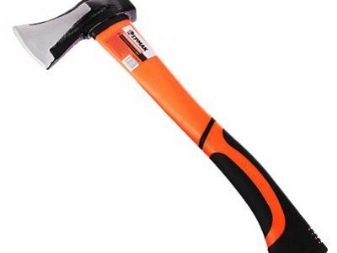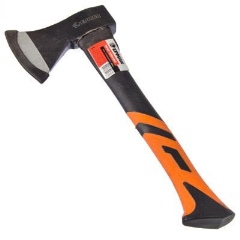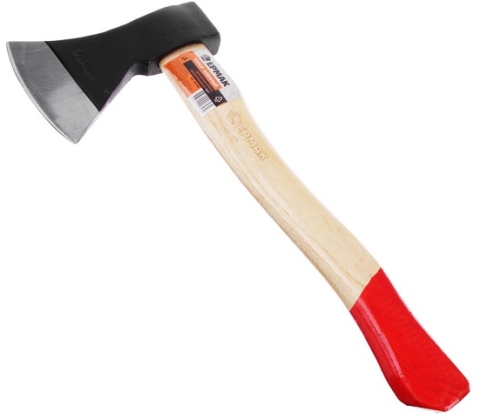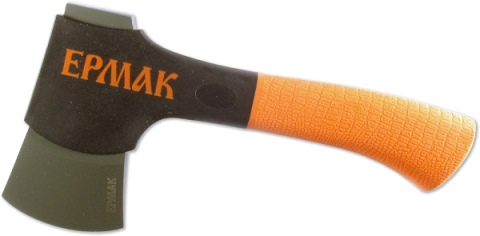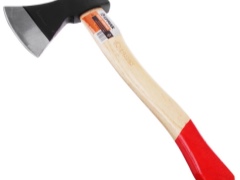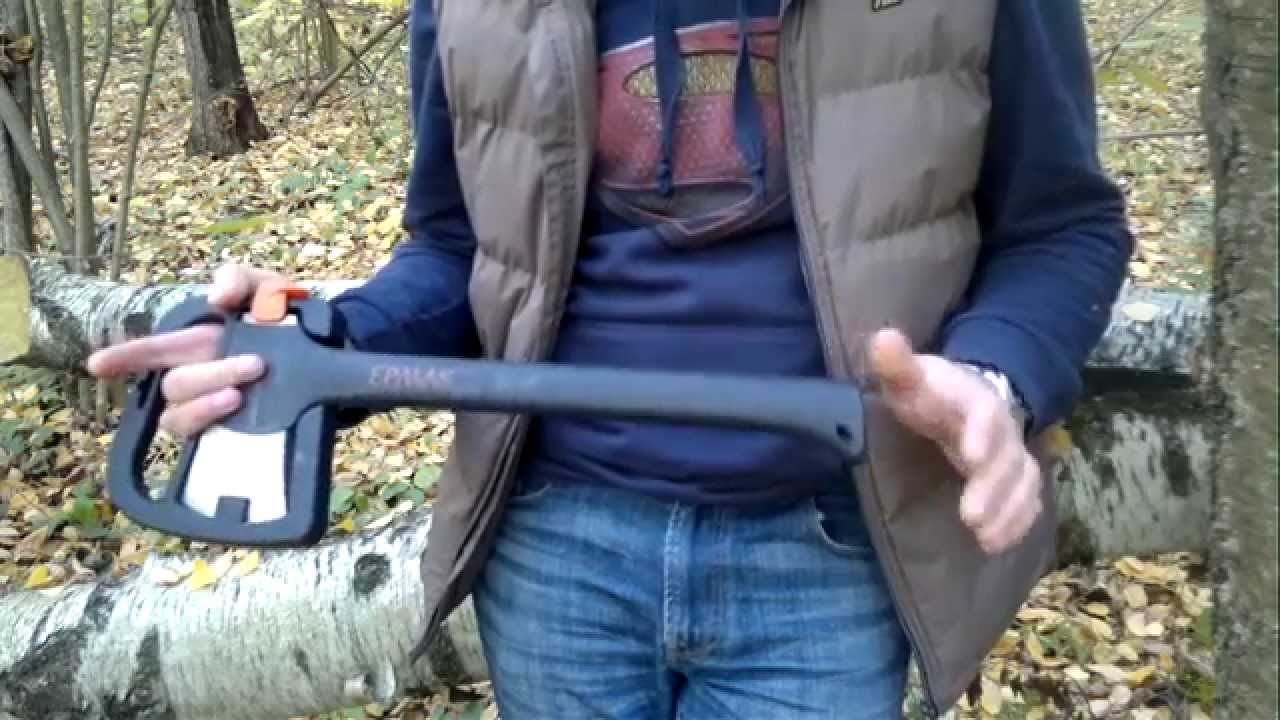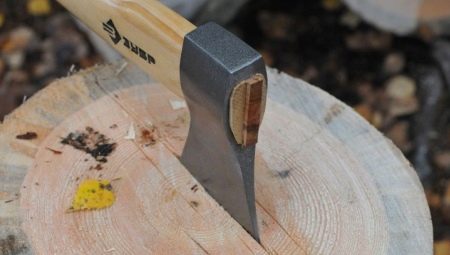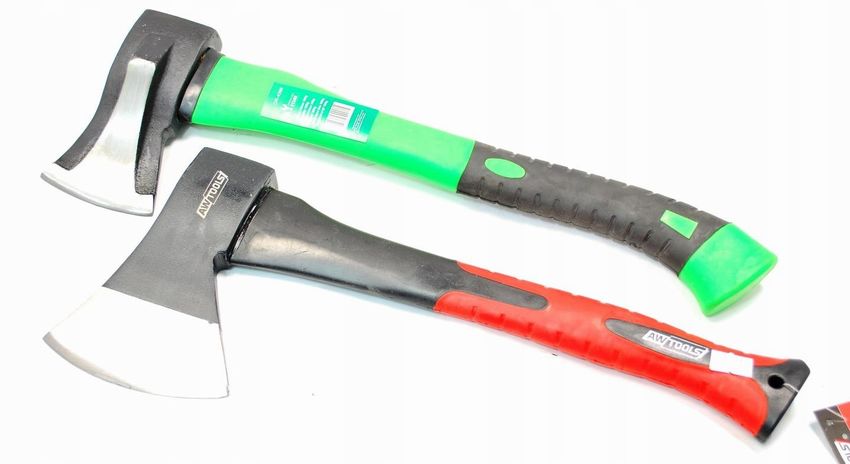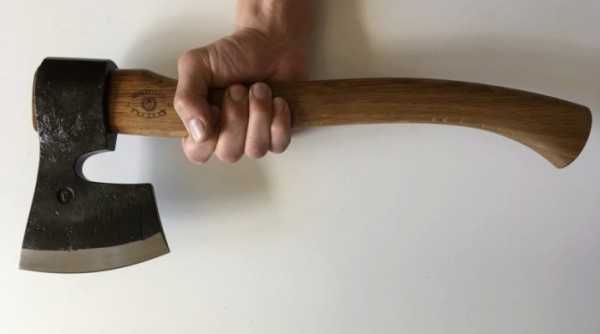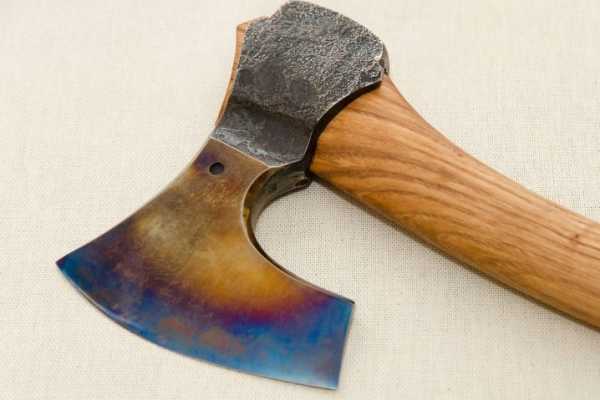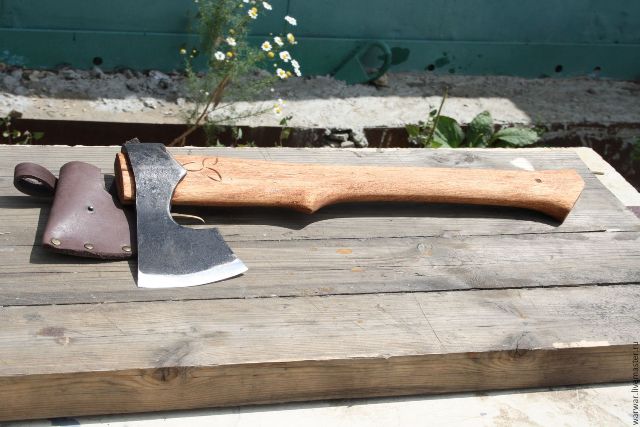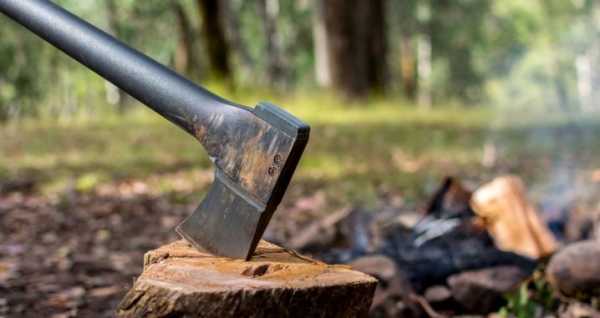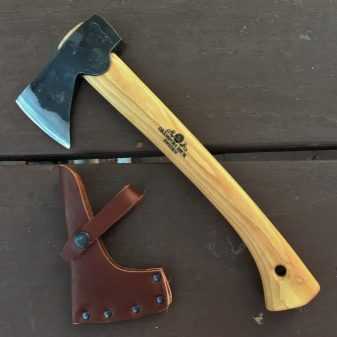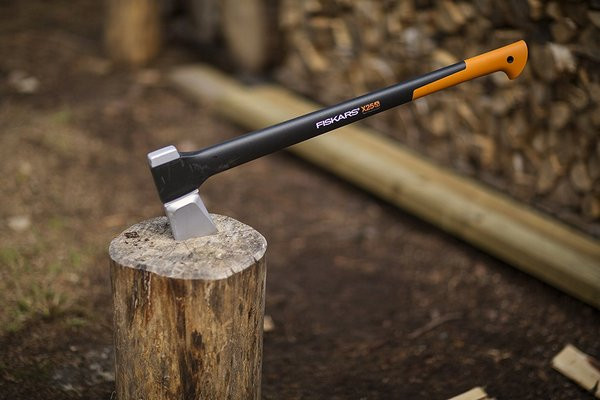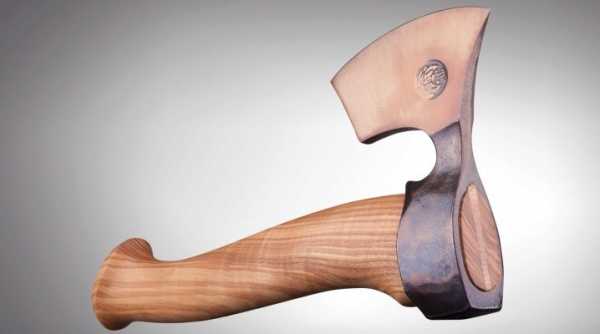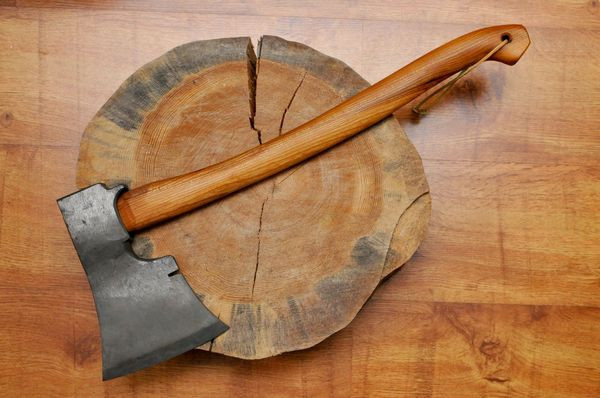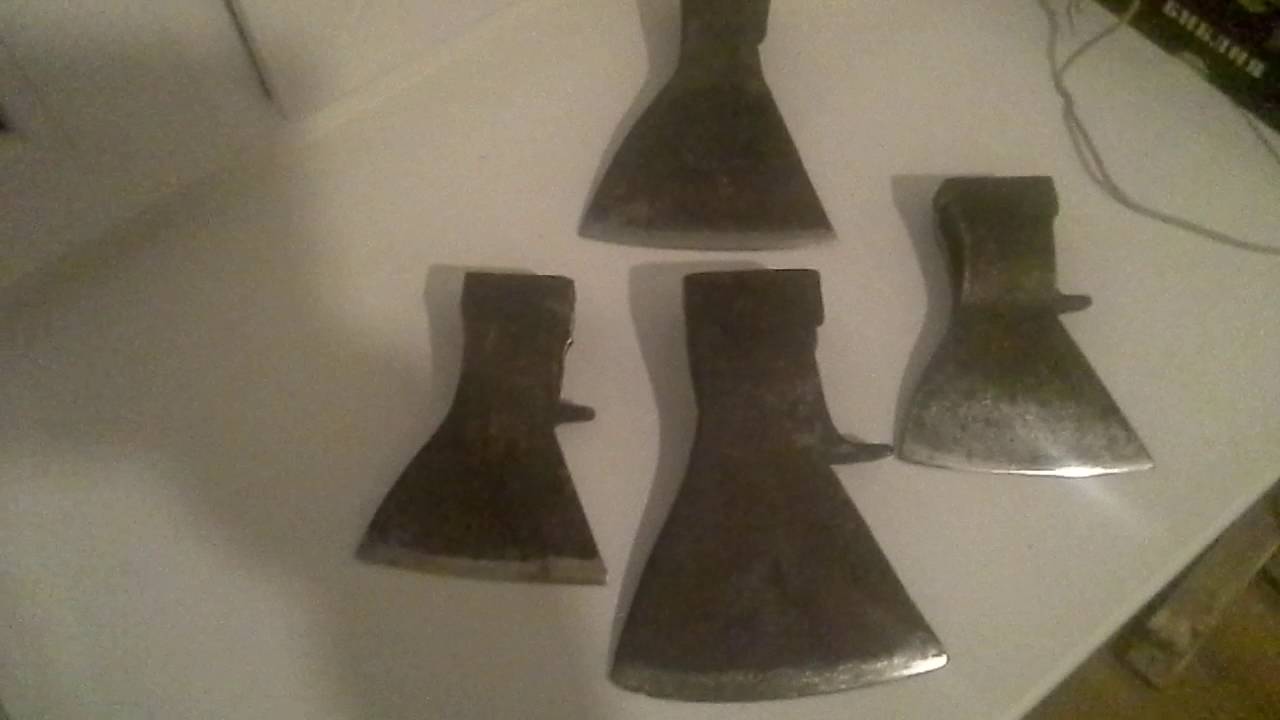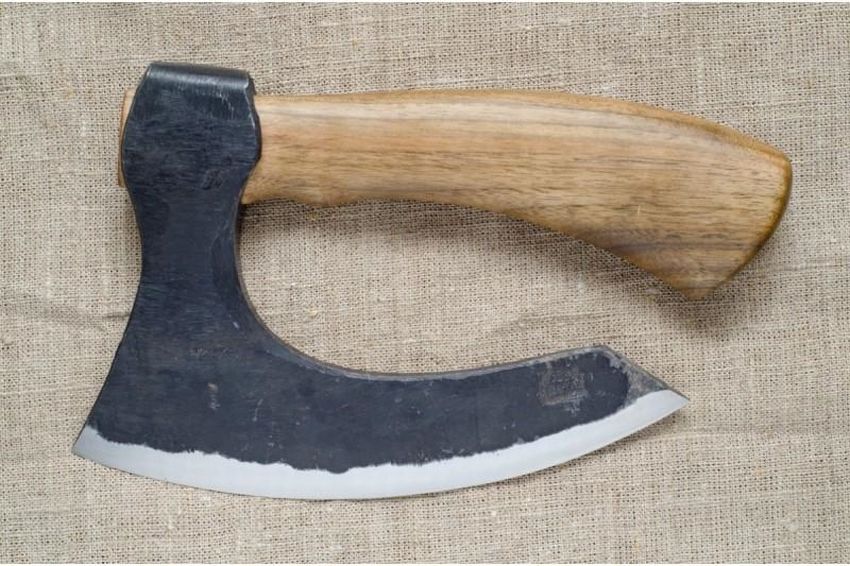Instructions on how to make a taiga ax
The product can be purchased at exhibitions or in a specialized store, ordered from a master. The handmade taiga ax is most appreciated, but it should be borne in mind that casting or forging a metal part at home will not work. The simplest solution is to make the necessary equipment from an ordinary carpentry (Figure 3).
To do this, follow the instructions on how to make a taiga ax with your own hands:
- Take an old metal head weighing about 1.5 kg and cut off the front protruding blade on it, flush with the butt.
- Make the back of the blade rounded, cut off excess metal with a grinder so that the entire touching surface is flat and has no corners.
- Saw out a neat semicircle on the inside of the remaining blade, reducing the head weight by 150-200 g.
- Round off the top corners of the butt with a medium-grit emery wheel - you can skip this operation if you are satisfied with the characteristics of the resulting tool.
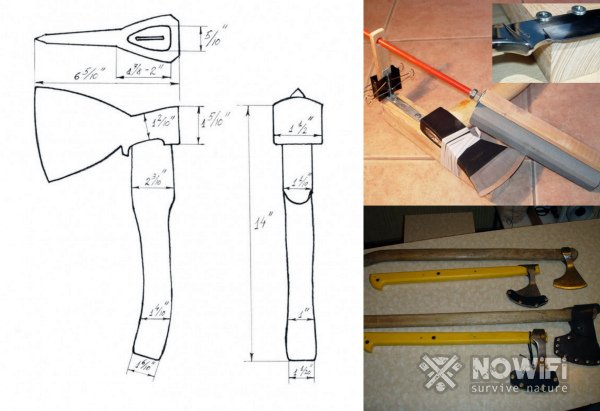 Figure 3. Drawings for self-manufacturing tools
Figure 3. Drawings for self-manufacturing tools
Converting an ordinary ax into a taiga one should also take into account the following points:
- If you want to leave a characteristic protrusion on the top of the head, it should not exceed 5-8 degrees.
- The presence of a semicircle on the inside is necessary - it is needed for a comfortable grip and accuracy of the work performed, they can also pull up small logs, cling to knots.
- When the butt is rounded, the weight decreases and the maneuverability of the product increases, but if you leave everything unchanged, it will be possible to wield it instead of a hammer.
Head making
The first thing you need is an old carpentry tool, or rather its metal tip.
To get the correct taiga ax, prepare the head in advance:
- Clean it from rust, sand down any chipping and cracks, small chips.
- If the damage is deeply ingrained, soak the metal for a day in a vinegar bath and sand it.
- Then proceed with the adjustment for the desired instance using emery and a grinder.
 Figure 4. Manufacturing of a metal head
Figure 4. Manufacturing of a metal head
Consider the dimensions and drawings of the taiga ax relative to the carpenter's ax when processing the workpiece (Figure 4).
Handle mounting
The shaft is an equally important part of the product, since the convenience and safety of using the tool depends on the correct installation and manufacture. To properly assemble a taiga ax with your own hands, you should carefully study the drawings and follow strict recommendations:
To properly assemble a taiga ax with your own hands, you should carefully study the drawings and follow strict recommendations:
Choose only hard woods for the handle - beech or ash is best.
Soak it with oil in several steps so that it does not get damp - with drying oil or wax.
UV-dry the shaft for extra durability, until it is dry and rough to the touch, no more wet or oily marks.
Pay attention to the location of the fibers - it should go strictly along the handle.
If they are sanded or at an angle, the wood will lose its durability.
 Figure 5. Stages of making a hatchet
Figure 5. Stages of making a hatchet
Drawings of the taiga ax handle will also be needed in order to comply with all dimensions during the installation process and correctly wedge the product (Figure 5).
Assembling the ax
The tool is a popular tool for hunting and game management, therefore, making a taiga ax with your own hands requires a responsible approach to the process of its assembly (Figure 6).
The metal part is pushed onto the butt of the handle so that the latter protrudes 1.5-2 cm above it.Under a tight fit, the head is removed and one longitudinal and two transverse cuts are made in the butt, not reaching the metal by about 0.5 cm. The cuts are drilled out, so that in the future the tree does not diverge.
From the same material that the handle is made, five suitable wedges are prepared and the entire structure is reassembled.
Any unnecessary elements are cut off, after which the product is carefully ground and sharpened. The attachment of the taiga ax handle deserves special attention. The landing site is reinforced with bandages or fastened with epoxy to enhance strength and greater density. Most often, beech wedges are hammered, or from the same wood as the handle itself - they securely fix the head with them.
 Figure 6. Instructions for assembling product parts
Figure 6. Instructions for assembling product parts
Since the epoxy deteriorates over time, its remnants are removed by burning a tool in a fire or replaced with wood glue.
Models
Among the large assortment of products of the company "Ermak" it is worth highlighting several models.
- Forged universal ax weighing 800 g with a wooden handle. It can be used for solving everyday tasks. Strong steel is used as a cutting blade, which perfectly withstands mechanical stress.
- Carpenter's ax weighing 575 g with a plastic handle. Used in the professional field. The metal surface is coated with Teflon. Handle length - 350 mm.
- Tool with a fiberglass two-component handle weighing 600 g. Ideal for the home, although it is versatile.


- Tourist "Fiskars X5 - XXS" with a blade length of 23 cm. Made entirely of steel, but lightweight (550 g).
- The 662-038 cleaver has a solid base made of forged 45 steel. Handle length - 90 cm, construction weight - 2.7 kg. Supplied for sale with a quality certificate.
- "Ermak 662-037" refers to the type of splitting axes, has a weight of 2 kg. The length of the entire tool is 88 cm, the length of the blade is 8.7 cm. The blade is made in a wedge shape using 45 steel. There is fiberglass on the handle, which significantly increases the comfort during the use of the tool.
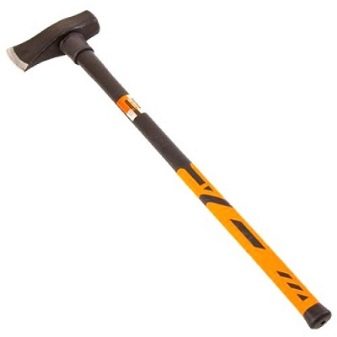

In the next video you will find an overview of the Ermak ax.
Choosing a manual cleaver
And yet, many ask the question: how to choose a cleaver? How to be sure of your choice and not regret it in the future? The following nuances will help you in this. Look at the cutting edge - the best are forged, cast and the steel is well heat treated.

Do you want to determine the quality of the metal? Click on it with your finger. The sound after clicking must become voiced, but if it is deaf, move on firmly. If you are a beginner, take a wooden cleaver, and if you are already experienced, take a look at the sample with a fiberglass hatchet. It is stronger and more durable.

The length and shape of the handle is at your discretion, rely on the sensations when you hold the ax in your hands, swing, because you will have to swing more than once. And it is also worth considering that it is better to give preference to Finnish, Russian, German and Swedish companies for the production of cleavers.

Be careful not to fall for a fake. If the splitting of firewood is at a high level, then buy strong devices from the best companies, and simple cleavers made by yourself are suitable for home purposes.

Options for choosing a good cleaver
There are simply no universal tips and recipes on how to choose the best cleaver for chopping wood. The choice of a tool depends on several important factors that are individual for any person:
- weight;
- length and material of the handle;
- blade shape.
Cleaver weight
Weight is perhaps the most controversial characteristic of a cleaver. If you look from one side, the more weighty the cleaver is, the easier it is to split thick chocks with its help.If you choose a light tool for the job, you will have to deliver several blows, while using a heavy cleaver allows you to get the job done with one blow.
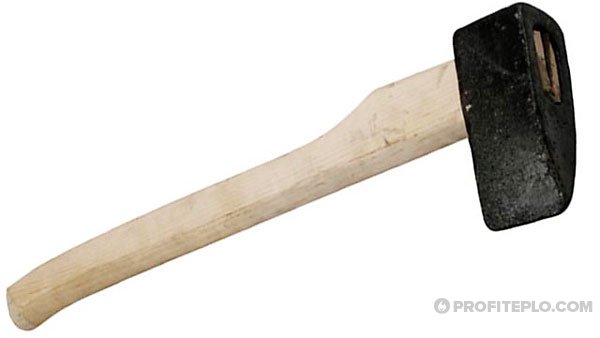 Traditional cleaver
Traditional cleaver
At the same time, it must be remembered that the preparation of firewood is a rather long and energy-intensive process; not everyone can swing a heavy tool for several hours. Therefore, it is better to choose a cleaver in accordance with your physical capabilities.
The correct cleaver for a person with average physical capabilities should have a mass of 2-2.5 kg. A heavier instrument should be preferred by people of great physical strength and considerable dimensions.
It is more convenient to split small chocks with a light cleaver, but difficulties may arise with medium-sized logs.
Blade shape
Which cleaver is suitable for harvesting firewood in most cases can be determined by the shape of the blade. There are two versions:
- wedge-shaped;
- the so-called "eared".
The latter species appeared relatively recently and has earned conflicting reviews from woodcutters.
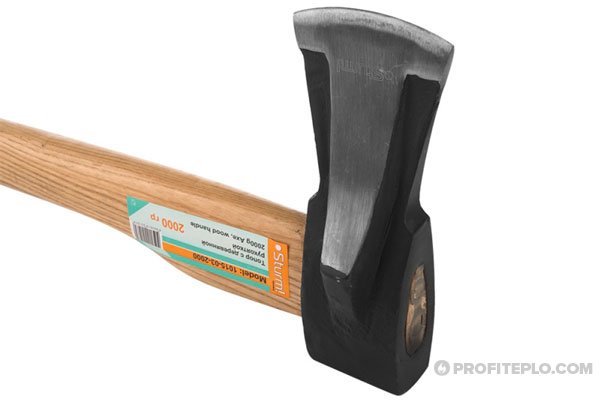 Cleaver ax
Cleaver ax
It is confirmed by many experienced cutters that such a tool often not only does not split the chock, but it gets stuck in it for a long time.
Based on this, it would seem, we can conclude that wedge-shaped cleavers are out of competition. But it is not so! Manufacturers of "eared" blades in the instructions give a small disclaimer: such a tool should only be used when working with dry wood.
Handle material and length
Not so long ago, there was no alternative to wooden cleavers.
Since time immemorial, both the wood chopping ax and the cleaver have been made with wood handles that have a unique ability to damp shock vibrations. It should be noted the prevalence of such material, its low cost, which for many is of decisive importance.
The only, but very significant disadvantage of wood handles is that when an inexperienced woodcutter is working, they can split. And the point here is not at all in the strength of the material or the marriage admitted during manufacture - the impact technique is of primary importance.
Relatively recently, an excellent replacement for wood was brought out - fiberglass composite material. Despite its lightness, this material is an order of magnitude superior to wood in strength and slightly falls short of metal in this indicator. The vibration damping properties of fiberglass are also very high, and therefore it is pleasant and convenient to work with such a handle. And if you take into account that, due to the low density of the handle, you can make any length without significantly increasing the weight of the tool, then it is better to prefer a cleaver with a fiberglass hatchet.
 Splitting ax with long fiberglass handle
Splitting ax with long fiberglass handle
The force of the cleaver's blow directly depends on the length of the ax - the longer the lever, the more force develops with its help. But to maximize the potential of the tool, you need to learn how to use it correctly. In other words, the use of a long ax will be effective only when an experienced person is working with the cleaver. For a beginner, a cleaver that is too large is more likely to be a burden.
So how to choose the right cleaver?
First of all, the mass of the tool should be selected depending on the physical development of the person who will use it.
Before buying, you should take into account whether dry or wet firewood will have to be chopped and, in accordance with this, give preference to wedge-shaped or "eared" blades.
The length and material of the handle are equally important selection criteria. In this case, the decisive factor is the lumberjack's experience and financial capabilities. A wood hatchet is not the most practical, but the cheapest option. It is better to choose a fiberglass pen, which, although it will cost more, will last much longer.
Varieties
All models presented by the manufacturer can be divided into the following types:
- carpentry;
- carpentry;
- cleavers;
- tourist.
Carpentry and joinery tools are used in the woodworking industry. The first has a lot of weight, and its edge on the cutting surface is rounded. This shape provides good material handling performance. The sharpening angle is from 30 to 35 degrees. Carpentry axes have less weight (on average, from 700 to 900 grams). The cutting edge is straight. The angle at which the sharpening is performed is 20-25 degrees. Such a tool is used to work with boards.
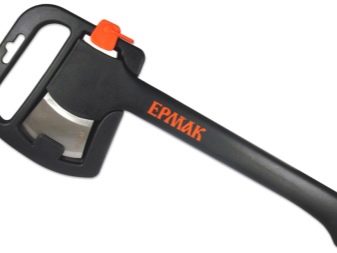

The tourist ax is notable for its small size and the presence of a special cover in the configuration. You can store such a hatchet in your backpack and use it while hiking. There are lightweight models weighing about 550 grams. Affordable cost is a definite plus of such products. The base is made of high quality forged steel with a hardness of 50-52HRC. More expensive models are equipped with a fiberglass handle.
As for the cleaver axes, they are made with a flat, thick blade. The canvas is very massive, the weight of the structure may differ depending on the purpose of the tool. Such an ax can weigh from 1 to 5 kilograms. This is due to the fact that when chopping firewood, a large scope is required. The handle is about 800 millimeters.

